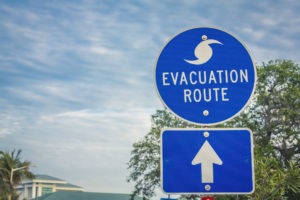The First 7 Things to Do During an Emergency Evacuation Procedure
 There are few things scarier than hearing that there is an emergency evacuation warning for your area. Some people even decide not to heed the warnings, though this can be a costly mistake. You have only a short window of time to pack up and leave your home. You don’t know what state your home may be in when you come back.
There are few things scarier than hearing that there is an emergency evacuation warning for your area. Some people even decide not to heed the warnings, though this can be a costly mistake. You have only a short window of time to pack up and leave your home. You don’t know what state your home may be in when you come back.
However, it’s important not to dwell on the what-ifs. During an emergency evacuation procedure, you must act quickly to ensure that what matters–your family–is safe. Here are the first 7 things you should do.
1. Gather the Essentials: Medicine and Food
During an evacuation, there is a good chance that food and water will soon be in short supply. You should gather enough supplies for at least a few days to take with you. Ideally, you would have gathered non-perishable foods and sealed water bottles in preparation for whatever is triggering the evacuation. If you didn’t, now is the time.
If anyone in your family requires medication, prescription or otherwise, packing that is a priority. Regardless of where you go, there is not likely to be an immediate stock of what you may need.
2. Gather Secondary Essentials
Once you have the food, water, and medicine you need, also gather other necessary items. Pack appropriate clothing for the climate. Opt for comfortable, sturdy shoes. If it will be cold, toss in sleeping bags and blankets.
Other good items to include are
- Flashlights
- Batteries
- Phone with solar, battery or vehicle charger
- Radio
- Candles and matches
Another thing to consider that is not often at the forefront of your mind in an emergency is important papers. In your home, there is probably an archive of information that would be difficult and costly to replace. Think documents like birth certificates, guardian paperwork, adoption paperwork, social security cards, etc. Try to always keep these documents together in one place so you can just grab and go in a hurry.
3. Secure Your Home
Secure your home as best you can before leaving. The type of disaster that is causing the evacuation will determine what steps are helpful. Emergency channels may be giving tips on what you can do so tune in for that. In most cases, you should unplug all electrical devices. Turn off the water and the gas, and depending on the emergency, the electricity. The last thing you want is for your house to survive the storm or earthquake, only to be destroyed in an explosion from a damaged gas line.
Looters are an unfortunate, yet common, plague during an evacuation. You can help protect your home as much as possible by securely locking up all the doors and windows before you leave.
4. Load up Your Pets
If it’s not safe for you, it’s not safe for your pets. Load up your pets and take them with you, along with enough food and water for them for a few days as well. However, keep in mind that if you plan to go to a shelter most places only accept service animals. In that case, try to stay with a friend or family member whose home is outside the affected area.
5. Download the FEMA App
If you haven’t already done so, download the FEMA app. This is a great resource provided by the Federal Emergency Management Agency.
Using the app, you can find shelters in your area and get real-time information about the space they have available. You can also get alerts and updates about the weather. The app offers a wealth of emergency tips and information tailored to over 20 different types of disasters. It’s a handy resource to have available during any type of emergency.
6. Check with Your Neighbors
On your way out, be sure to do a quick check with your neighbors to make sure that everyone is getting out okay. Someone may need a ride or the elderly couple down the street may need helping loading their car. Every minute counts during an emergency and if people work together, there is a better chance that everyone can get out safely.
7. Stick to Recommended Routes
As you’re headed out, be sure to stick to the recommended routes. You might think you can save time by taking that shortcut you know about. After all, everyone else is going to be clogging up the recommended routes. However, that shortcut may be blocked or otherwise unusable. There may be a good reason that it doesn’t show up on the recommended route list. So for a greater chance of success at getting out safely and on time, follow the evacuation routes.
Emergency Evacuation Procedure: Final Steps
Once you’ve made it safely out of the affected area, be sure to keep yourself up to date. Don’t try to re-enter the evacuation area until official channels say that it’s safe. It can be tempting to go back when you think that all is clear. After all, losing your home can be a devastating occurrence and you want to avoid it if at all possible.
If officials haven’t given the all-clear, then there is still something unsafe about going back. It would be far more devastating to lose a family member, or your own life, by not heeding official advice.
Knowing what to do during an emergency evacuation procedure is very important. It’s also important to know who to call afterward. If you need help with disaster recovery after a wildfire, earthquake, storm or whatever else, feel free to contact us today!
